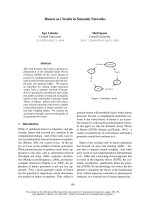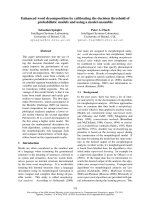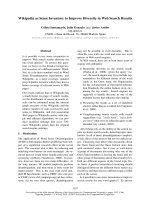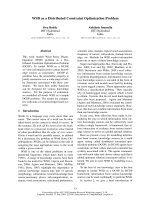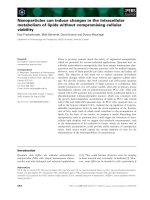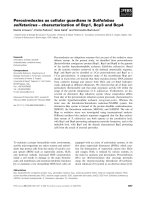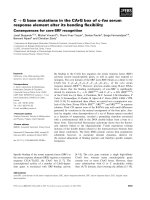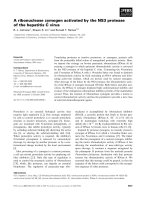Báo cáo khoa học: Peroxiredoxins as cellular guardians in Sulfolobus solfataricus – characterization of Bcp1, Bcp3 and Bcp4 pot
Bạn đang xem bản rút gọn của tài liệu. Xem và tải ngay bản đầy đủ của tài liệu tại đây (948.65 KB, 11 trang )
Peroxiredoxins as cellular guardians in Sulfolobus
solfataricus – characterization of Bcp1, Bcp3 and Bcp4
Danila Limauro
1
, Emilia Pedone
2
, Ilaria Galdi
1
and Simonetta Bartolucci
1
1 Dipartimento di Biologia Strutturale e Funzionale, Universita
`
di Napoli ‘Federico II’, Complesso Universitario Monte S. Angelo, Naples, Italy
2 Istituto di Biostrutture e Bioimmagini, CNR, Naples, Italy
To maintain a proper intracellular redox environment,
aerobic microorganisms use redox systems and antioxi-
dants that protect cells from the attack of reactive oxy-
gen species (ROS) such as superoxide anions, H
2
O
2
and hydroxyl radicals. Increased ROS concentration
inside a cell results in damage to the main biomole-
cules and membranes and essential metabolic functions
[1]; to maintain a low intracellular ROS level, cells are
equipped with an array of antioxidant systems, in the
first place superoxide dismutases (SODs), which cata-
lyze the dismutation of superoxide anions into H
2
O
2
and oxygen. H
2
O
2
is reduced by various systems, in
the main by catalases and peroxidases. Peroxiredoxins
(Prx) are thiol-peroxidases that scavenge peroxides
using the enzyme-recycling thioredoxin (Trx) ⁄ thiore-
doxin reductase (Tr) system as an electron donor [2,3].
Keywords
antioxidant; archaea; disulfide
oxidoreductase; oxidative stress;
thiol-peroxidase
Correspondence
Simonetta Bartolucci, Dipartimento di
Biologia Strutturale e Funzionale, Complesso
Universitario di Monte S. Angelo,
Universita
`
di Napoli ‘Federico II’, Via Cinthia,
80126 Naples, Italy
Fax: +39 081679053
Tel: +39 081679052
E-mail:
(Received 20 December 2007, revised 22
February 2008, accepted 27 February 2008)
doi:10.1111/j.1742-4658.2008.06361.x
Peroxiredoxins are ubiquitous enzymes that are part of the oxidative stress
defense system. In the present study, we identified three peroxiredoxins
[bacterioferritin comigratory protein (Bcp)1, Bcp3 and Bcp4] in the genome
of the aerobic hyperthermophilic archaeon Sulfolobus solfataricus. Based
on the cysteine residues conserved in the deduced aminoacidic sequence,
Bcp1 and Bcp4 can be classified as 2-Cys peroxiredoxins and Bcp3 as a
1-Cys peroxiredoxin. A comparative study of the recombinant Bcps pro-
duced in Escherichia coli showed that these enzymes protect DNA plasmid
from oxidative damage and remove both H
2
O
2
and tert-butyl hydroper-
oxide, although at different efficiencies. We observed that all of them were
particularly thermostable and that peak enzymatic activity fell within the
range of the growth temperature of S. solfataricus. Furthermore, we dis-
covered an alternative Bcp reduction system whose composition differs
from that of the peroxiredoxin reduction system previously characterized in
the aerobic hyperthermophilic archaeon Aeropyrum pernix. Whereas the
latter uses the thioredoxin ⁄ thioredoxin reductase ⁄ NADPH system, this
alternative Bcp system is formed of the protein disulfide oxidoreducatase,
SSO0192, the thioredoxin reductase, SSO2416, and NADPH. The role of
Bcps in oxidative stress was investigated using transcriptional analysis.
Different northern blot analysis responses suggested that the Bcp antioxi-
dant system of S. solfataricus can both operate at the constitutive level,
with Bcp1 and Bcp4 preventing endogenous peroxide formation, and at the
inducible level, with Bcp3 and the already characterized Bcp2 protecting
cells from the attack of external peroxides.
Abbreviations
Bcp, bacterioferritin comigratory protein; Cys
p,
peroxidatic cysteine; Cys
R,
resolving cysteine; MCO, metal ion catalyzed oxidation; PDO,
protein disulfide oxidoreductase; ROS, reactive oxygen species; SOD, superoxide dismutase; ssSOD, SOD from Sulfolobus solfataricus;
t-BOOH, tert-butyl hydroperoxide; Tr, thioredoxin reductase; Trx, thioredoxin.
FEBS Journal 275 (2008) 2067–2077 ª 2008 The Authors Journal compilation ª 2008 FEBS 2067
Prxs are ubiquitous enzymes identified in eubacteria,
archaea, yeast, algae, higher plants and animals [4,5].
All Prxs share the same basic catalytic mechanisms,
whereby a cysteine conserved in the N-terminal
sequence, the peroxidatic cysteine (Cys
p
), is oxidized to
sulfenic acid (Cys-S
P
OH) by a peroxide substrate.
These enzymes are generally distinguished into 2-Cys
or 1-Cys based on whether or not they contain the
resolving cysteine (Cys
R
). In 2-Cys Prxs, the Cys-S
P
OH
and Cys-S
R
react and form a disulfide (C
P
-S-S-C
R
):
the stable disulfide form is then reduced by one of sev-
eral disulfide oxidoreductases, completing the catalytic
cycle. 2-Cys Prxs have been further distinguished into
typical or atypical, depending on the location of Cys-
S
R
residue. In typical 2-Cys-Prxs, the Cys-S
P
OH reacts
with the Cys-S
R
residue located in the C-terminal
sequence of the other subunit of the antiparallel
homodimer. By contrast, in atypical 2-Cys Prx, the
Cys-S
R
residue resides within the same subunit.
Although catalases mainly detoxify high levels of
H
2
O
2
, the function of Prxs is to scavenge low levels of
H
2
O
2
[6]. It has been demonstrated that Prxs with a
K
M
in the low lm range are kinetically more efficient
scavengers of trace amounts of H
2
O
2
than catalases,
and this is why they are probably the primary defence
against endogenous hydrogen peroxide. More than 40
proteins have been found to perform a similar function
in a variety of organisms, ranging from bacteria and
eukarya to archaea. A hexadecameric Prx [3] belonging
to the 2-Cys Prx family has recently been isolated in
the archaeon Aeropyrum pernix and the enzyme was
found to be dependent on the Trx ⁄ Tr ⁄ NADPH system
for H
2
O
2
reduction.
Another archaeal Prx from Pyrococcus horikoshii
PH1217 [7,8] has been characterized and subsumed
within the 2-Cys family. Although it performs peroxi-
dase activity, its electron donor partner may differ
from that found in A. pernix.
On evaluation, the Sulfolobus solfataricus P2 genome
[9] was found to contain no putative amino acid
sequences that are homologues of catalases, but four
homologues of Prxs, annotated as bacterioferritin
comigratory protein (Bcp)1, Bcp2, Bcp3 and Bcp4.
Indeed, the antioxidant system of S. solfataricus P2
has so far been identified only in part, in that only two
enzymes have been characterized: SOD from S. solfa-
taricus (SsSOD) [10] and a 1-Cys Prx (Bcp2) [11].
SsSOD has a homodimeric structure that is sensitive
to inactivation by H
2
O
2
. Its half-life is 2 h at 100 °C
[12]. SsSOD has been found both in the culture fluid of
S. solfataricus during growth on glucose-rich media and
is associated with the cell surface. There is evidence that
cell-associated SsSOD protects both the cell surface
enzyme glucose dehydrogenase and the integral-mem-
brane enzyme succinate dehydrogenase against oxyradi-
cal protein deactivation [13]. Transcriptional analysis
has provided evidence of constitutive gene expression.
Moreover, the high stability of the 2 h half-life mRNA
suggests that high SsSOD levels are likely to protect the
cells from the superoxide anion generated in the natural
oxidant environment of S. solfataricus [14,15].
Bcp2 is a recently characterized Prx; its transcription
in S. solfataricus is up-regulated by various stressors
and the different kinetics observed in response to these
agents could imply different regulatory mechanisms, or
at least variations in the same mechanism. Further-
more, Bcp2 displays peroxidase activity at a tempera-
ture optimum in the range 80–90 °C (i.e. the range in
which S. solfataricus grows). The peroxidase activity of
Bcp2 involves the single cysteine residue (Cys
49
) in the
catalytic activity, suggesting a mechanism whereby
the residue is oxidized by H
2
O
2
and then reduced by
the dithiothreitol used as electron donor in vitro [11].
No physiological partner has so far been identified. A
new redox system formed of the protein disulfide oxi-
doreductase (PDO) SSO0192 and the Tr SSO2416 has
recently been characterized in S. solfataricus. SSO0192
is a typical PDO, a member of the protein disulfide
isomerase-like family [16], whose redox and chaperone
activities confirm a central role in the biochemistry of
cytoplasmic disulfide bonds and suggest a potential
role in intracellular protein stabilization, respectively
[17]. Recent investigations of the genomic sequence
databases of S. solfataricus led to the identification of
two putative Trxs (i.e. TrxA1 and TrxA2; SSO0368
and SSO2232, respectively). Unlike SSO0192, which is
part of the new thioredoxin system SSO0192 ⁄ SSO2416,
both these Trxs proved to be inactive in reduction with
SSO2416 [17].
The present study aims to expand our knowledge of
the antioxidant system in S. solfataricus. Accordingly,
we characterize three Prxs deduced from the S. solfa-
taricus P2 genome: we report on the cloning of bcp1,
bcp3 and bcp4 and the characterization of the recombi-
nant products and, next, we investigate the possible
role of the SSO0192 ⁄ SSO2416 system as an in vivo
partner of Bcps in enzyme recycling. Subsequently,
transcriptional studies help to shed light on the tactic
used by S. solfataricus during oxidative stress.
Results
Sequence analysis of Bcp1, Bcp3 and Bcp4
Four genes encoding the putative Prxs named Bcp1
(SSO2071), Bcp2 (SSO2121), Bcp3 (SSO2255) and
Peroxiredoxin antioxidant system D. Limauro et al.
2068 FEBS Journal 275 (2008) 2067–2077 ª 2008 The Authors Journal compilation ª 2008 FEBS
Bcp4 (SSO2613) were identified in the S. solfataricus
genome database ( />sulfolobus/). One of them, Bcp2 (215 amino acids,
with a predicted molecular mass of 24 744.79 Da and
a theoretical pI of 6.85), has recently been character-
ized and classified as a 1-Cys Prx [11].
bcp1 encodes a putative protein of 153 amino acids
with a predicted molecular mass of 17 460.12 Da and
a theoretical pI of 7.73; bcp4 encodes a putative pro-
tein of 156 amino acids with a predicted molecular
mass of 17 461.28 Da and a theoretical pI of 7.65;
bcp3 encodes a putative protein of 149 amino acids
with a predicted molecular mass of 16 976.42 Da and
a theoretical pI of 8.84. Comparison of the sequences
of S. solfataricus Bcps revealed an approximate 35%
identity for Bcp1, Bcp3 and Bcp4.
A BlastP search against the Swiss-Prot ⁄ TrEMBL
GenBank database identified numerous Prx homo-
logues of Bcp1, Bcp3 and Bcp4. The highest identity
of Bcps is found with archaeal thermophilic Prxs
(Figs 1–3). The Bcp1 and Bcp4 amino acid sequences
include two cysteine residues at positions 45 and 50
of the highly conserved N-terminal region and show
significant identity with chloroplastic PrxQ, which is
involved in antioxidant defence and in the redox
homeostasis of photosynthesis [18]; by contrast, the
Bcp3 sequence only shows one cysteine at position 42
in the N-terminal region.
Expression and purification of Bcp1, Bcp3 and
Bcp4
bcp1, bcp3 and bcp4 were amplified by PCR from
S. solfataricus genomic DNA and cloned into pET-
30c(+). The genes were expressed in Escherichia coli
cells and the recombinant proteins were highly overex-
pressed in soluble form, as fusions with a C-terminal
eight-residue histidine tag (LEHHHHHH), with an
approximate 10% yield of homogeneous proteins.
To purify the recombinant Bcps, the soluble frac-
tions (140 mg) of the cell extracts were heated at 80 °C
for 15 min; this heat-treatment removed approximately
40% of E. coli proteins. Bcp1 was purified to homoge-
neity in a one-stage process using affinity chromato-
graphy on HisTrap HP. SDS ⁄ PAGE of the final
preparation revealed a single band with a molecular
Fig. 1. Sequence alignment of Bcp1. CLUSTALW alignment of S. solfataricus (Bcp1) Q97WP9|SULSO, S. acidocaldarius Q4J6R7|SULAC,
S. tokodaii Q974D1|SULTO, Picrophilus torridus Q6L214|PICTO, Anabaena variabilis Q3M6A0|ANAVT, and Synechococcus sp. Q31LU7|SYNP7.
D. Limauro et al. Peroxiredoxin antioxidant system
FEBS Journal 275 (2008) 2067–2077 ª 2008 The Authors Journal compilation ª 2008 FEBS 2069
mass of 18 ± 1 kDa. Bcp3 and Bcp4 required an addi-
tional purification step with cation and anion-exchange
chromatography, respectively.
The molecular masses of the three recombinant pro-
teins were determined using MS analysis as reported
in the Experimental procedures; the values reported
for Bcp1 (18 525 Da), Bcp3 (18 041 Da) and Bcp4
(18 526 Da) were in agreement with the corresponding
theoretical values. The quaternary structure of the
enzymes was assessed via analytical gel filtration of the
purified proteins: Bcp1 and Bcp3 were eluted at a vol-
ume consistent with a monomeric structure whereas
Bcp4 was eluted consistently with its dimeric structure.
Peroxidase activity
The peroxidase activity of recombinant Bcps was tested
in vitro via a metal ion catalyzed oxidation (MCO)
assay. The assay was based on the ability to protect plas-
mids against Fe
3+
-catalyzed reduction of O
2
to H
2
O
2
,
which occurs in the presence of an electron donor, such
as dithiothreitol. Via the Fenton reaction, the H
2
O
2
formed in these conditions was further converted into
HO
.
, which nicks supercoiled plasmid DNA. Accord-
ingly, we investigated whether recombinant Bcp1, Bcp3
and Bcp4 could protect DNA from oxidative damage in
terms of removing the H
2
O
2
, generated by the MCO
system. As shown in Fig. 4A–C (lanes 2), in the pres-
ence of the MCO system, the supercoiled form of
pUC19 was completely converted into nicked form,
whereas the addition of Bcp1, Bcp3, or Bcp4 to the reac-
tion mixture averted this damage. In more detail, 2 lm
of Bcp3 was sufficient to remove the H
2
O
2
generated by
the MCO system and to preserve the supercoiled DNA
plasmid form (Fig. 4B, lane 6); whereas 40 lm and
20 lm of Bcp1 and Bcp4 (Fig. 4A, lane 6 and Fig. 4C,
lane 6), were only partially able to convert nicked into
supercoiled plasmid; BSA and Bcp2 were used as nega-
tive and positive controls, respectively.
Subsequently, using dithiothreitol as electron donor
for enzyme recycling, we further investigated the anti-
oxidant activity of Bcps by measuring both H
2
O
2
and the organic peroxide tert-butyl hydroperoxide
(t-BOOH) removed. A non-enzymatic spectrophoto-
metric assay was performed as described in the Experi-
mental procedures. Bcp1, Bcp3 and Bcp4 were capable
Fig. 2. Sequence alignment of Bcp3. CLUSTALW alignment of S. solfataricus (Bcp3) Q97WG5|SULSO, S. tokodaii Q96YS1|SULTO, S. acido-
caldarius Q4JCJ2|SULAC, A. pernix Q9YG15|AERPE, Pyrobaculum aerophilum Q8ZYA3|PYRAE, and Thermoplasma acidophilum
Q9HL73|THEAC.
Peroxiredoxin antioxidant system D. Limauro et al.
2070 FEBS Journal 275 (2008) 2067–2077 ª 2008 The Authors Journal compilation ª 2008 FEBS
of scavenging both H
2
O
2
and t-BOOH, although at
different efficiencies. The results shown in Fig. 5A
demonstrate that 2.5 lm of Bcp1 is sufficient to
remove approximately 50% of the existing H
2
O
2
and
that Bcp4 at the same concentration and 1.4 lm Bcp3,
respectively, remove all the peroxides. Figure 5B shows
the activity of the same enzymes when t-BOOH is used
as a substrate: 8 lm of Bcp1 and Bcp4 remove approx-
imately 50% of the t-BOOH, a proportion which rises
to approximately 90% when Bcp3 is used at the same
concentration. In conclusion, Bcp1 Bcp3 and Bcp4 are
more efficient when H
2
O
2
is used as substrate in place
of t-BOOH.
To determine the physiological partners involved in
Bcp reduction in vivo, we used the redox Trx-like system
of S. solfataricus comprising the PDO member
SSO0192, the Tr SSO2416 and NADPH [17]. The H
2
O
2
consumption rate at 80 °C was measured by monitoring
the decrease in A
490
, as in the previous assay. We found
that Bcp1, Bcp3 and Bcp4 were also capable of perform-
ing their peroxide reductase activity in the presence of
the Trx-like system (Fig. 6), although at a slightly lesser
efficiency compared to dithiothreitol. These results indi-
cate that Bcp1, Bcp3 and Bcp4 are functional Trx-like
peroxidases, whereas Bcp2, which was previously
reported to remove H
2
O
2
in the presence of dithiothrei-
tol [11], is unable to eliminate H
2
O
2
in the presence of
the SSO2416 ⁄ SSO0192 ⁄ NADPH system. In all likeli-
hood, the different response observed for Bcp2, com-
pared to the other three enzymes, either reflects a
different oxidized catalytic center accessibility or a
different reaction mechanism.
Fig. 3. Sequence alignment of Bcp4. CLUSTALW alignment of S. solfataricus (Bcp4) Q97VL0|SULSO, S. acidocaldarius Q4J9Q3|SULAC
S. tokodaii Q96ZP9|SULTO, Thermotoga marittima Q9WZN7|THEMA, Orysa sativa PRXQ|ORSSJ, and Arabdopsis thaliana PRXQ|ARATH.
D. Limauro et al. Peroxiredoxin antioxidant system
FEBS Journal 275 (2008) 2067–2077 ª 2008 The Authors Journal compilation ª 2008 FEBS 2071
Temperature dependence and thermostability
of Bcp1, Bcp3 and Bcp4
To characterize the thermophilicity of recombinant
Bcp1, Bcp3 and Bcp4, we investigated the peroxidase
activities of the enzymes by measuring H
2
O
2
removal
at increasing temperatures. Bcp1 and Bcp3 activity
was shown to be highest at 85 °C, which is in the
optimum temperature range for S. solfataricus growth
(Fig. 7A,B), whereas Bcp4 showed maximum peroxi-
dase activity in the range 95–100 °C, the highest
temperature tested (Fig. 7C). At this point, we deter-
mined the thermoresistance levels of the enzymes by
incubating them for varying periods at 80, 90, 95 and
100 °C and then assaying their respective residual per-
oxidase activity (data not shown). Following a 2 h
incubation at 80 °C, all the enzymes were shown to
have retained 100% of their initial activity; Bcp1 dis-
played a half-life of 2 h at 95 °C but, after a 60 min
incubation at 100 °C, its relative activity dropped to
20% of the starting value. Bcp3 and Bcp4 are more
thermostable than Bcp1: after 2 h at 100 °C, they
A
B
C
N
F
SF
12 43657
NF
SF
12 43657
NF
SF
12 43657
SF
NF
SF
12 4365
NF
SF
12 4365
Fig. 4. DNA cleavage protection assay performed by Bcp1 (A),
Bcp3 (B) and Bcp4 (C). Supercoiled pUC19 plasmid (lanes 1) was
exposed to the MCO system (dithiothreitol ⁄ Fe
+3
⁄ O
2
) alone (lanes 2)
and with different Bcps concentrations. pUC19 plus the MCO sys-
tem plus Bcp2 1 l
M as positive control (lanes 3), pUC19 plus the
MCO system plus BSA as negative control (lanes 7). pUC19 plus
the MCO system plus Bcp1 2 l
M (lane 4A) or Bcp1 20 lM (lane 5A)
or Bcp1 40 l
M (lane 6A). pUC19 plus the MCO system plus Bcp3
1 l
M (lane 4B) or Bcp3 1.5 lM (lane 5B) or Bcp3 2 lM (lane 6B).
pUC19 plus the MCO system plus Bcp4 1 l
M (lane 4C) or Bcp4
10 l
M (lane 5C) or Bcp4 20 lM (lane 6C). NF, nicked form; SF,
supercoiled form of pUC19 are indicated on the left by arrows.
H
2
O
2
removal (%)
Bc
p
s (
µ
M)
0
20
40
60
80
100
A
0 1 2 3 4
5
Bc
p
s (
µ
M)
B
0
20
40
60
80
100
t-BOOH removal (%)
0 4 8 12 16
Fig. 5. Different efficiency of Bcps in removing H
2
O
2
(A) and t-BOOH (B). Peroxidase activity was measured using the ferrithiocyanate
method at 80 °C as described in the Experimental procedures in the presence of dithiothreitol as an electron donor. Bcp1(d), Bcp3 (
),
Bcp4 (
).
0
20
40
60
80
100
12345
Relative activity (%)
Fig. 6. Peroxidase activity of recombinant Bcps in the presence
of the SSO2416 ⁄ SSO0192 ⁄ NADPH system of S. solfataricus.
SSO0192 ⁄ SSO2416 ⁄ NADPH + H
2
O
2
negative control (1),
SSO0192 ⁄ SSO2416 ⁄ NADPH + H
2
O
2
+ Bcp1 5 lM (2), SSO0192 ⁄
SSO2416 ⁄ NADPH + H
2
O
2
+ Bcp2 5 lM (3), SSO0192 ⁄ SSO2416 ⁄
NADPH + H
2
O
2
+ Bcp3 4 lM (4), SSO0192 ⁄ SSO2416 ⁄ NADPH +
H
2
O
2
+ Bcp4 5 lM (5).
Peroxiredoxin antioxidant system D. Limauro et al.
2072 FEBS Journal 275 (2008) 2067–2077 ª 2008 The Authors Journal compilation ª 2008 FEBS
both showed similar half-lives but, after 2 h at 95 °C,
relative activity had dropped to 92% for Bcp4 and to
60% for Bcp3. Interestingly Bcp4 is found to be
fairly resistant in 6 m urea: after a 30 min incubation,
the enzyme retained 50% of its activity (data not
shown).
Transcriptional analysis of bcp1, bcp3 and bcp4
under oxidative stress
The involvement of bcp1, bcp3 and bcp4 in oxidative
stress was investigated by assessing mRNA levels fol-
lowing treatment of S. solfataricus cells with H
2
O
2
and
t-BOOH as direct oxidants and with paraquat, which
was used to generate superoxide anions [15]. To estab-
lish the concentrations of agents capable of slowing
down or otherwise affecting growth, the cells were
treated with different amounts of stressors in the expo-
nential phase [11]. Therefore, the S. solfataricus P2
strain was grown until the early exponential phase (0.3
A
600
) and then induced with 0.1 mm paraquat,
0.05 mm H
2
O
2
and 0.05 mm t-BOOH for varying
periods (Fig. 8A–C). The hybridizing bands in the
northern analysis revealed the expected size of approxi-
mately 500 bp, indicating that the genes are
transcribed as monocistronic mRNAs. When S. solfa-
taricus cells were incubated with paraquat, H
2
O
2
and
t-BOOH, the bcp1 and bcp4 mRNA levels did not
increase appreciably, whereas, 15 min after the addi-
tion of H
2
O
2
, the level of bcp3 mRNA was found to
have risen approximately five-fold.
Discussion
Prxs are recently identified thiol peroxidases and are
ubiquitous among both prokaryotes and eukaryotes.
bcp1
16S rRNA
bcp4
16S rRNA16S rRNA16S rRNA
bcp3
16S rRNA
paraquat
0153060015
A
B
C
30 60
H
2
O
2
0153060
t-BOOH
paraquat
0153060
01530
60
H
2
O
2
01530
60
t-BOOH
0
15 60
paraquat
06015 30
t-BOOH
0153060
H
2
O
2
rRNA16S rRNA
Fig. 8. Transcriptional response of bcp1,
bcp3 and bcp4 to oxidative stress. Cultures
of S. solfataricus P2 were grown until the
mid-exponential phase and treated with
0.05 m
M H
2
O
2
, 0.1 mM paraquat, 0.05 mM
t-BOOH for different times. RNAs were
obtained from culture harvested at the time
shown The arrows indicate the transcript of
bcp1 (A), bcp3 (B) and bcp4 (C). The tran-
scripts of 16S rRNA were reported for
normalization.
Tem
p
erature (°C)
0
20
40
60
80
100
02040
A
BC
60 80 100
Tem
p
erature (°C)
020406080100
Tem
p
erature (°C)
020406080100
Relative activity (%)
0
20
40
60
80
100
Relative activity (%)
0
20
40
60
80
100
Relative activity (%)
Fig. 7. Temperature dependence of Bcp1, Bcp3 and Bcp4. Bcp1 (A), Bcp3 (B) and Bcp4 (C) were incubated under the conditions described
in the Experimental procedures with 0.2 m
M H
2
O
2
. The peroxidase activity was assayed at different temperatures using the ferrithiocyanate
method. The non-enzymatic removal of H
2
O
2
by heat was performed in parallel.
D. Limauro et al. Peroxiredoxin antioxidant system
FEBS Journal 275 (2008) 2067–2077 ª 2008 The Authors Journal compilation ª 2008 FEBS 2073
They are classified into several subfamilies based on
the number and locations of the conserved cysteine
residues that they contain, on subunit composition, on
the nature of the electron donor involved in their
reduction, and on structural comparison analysis [19].
Recent studies of multigenic Prx families present
in cyanobacteria, such as Synechococcus elongatus
PCC7942 and Synechocystis sp. PCC6803 [18], and the
characterization of Prxs from plants, have led to the
identification of a new class of Prxs named PrxQ, simi-
lar to Bcps occurring in E. coli, [20]. This family is
characterized by a Trx-dependent peroxidase activity,
a primary structure in which the two conserved cyste-
ine residues in the N-terminal region are separated by
five amino acids, and by a similar molecular weight of
approximately 17 kDa.
The discovery of Prxs in archaea, defined together
with cyanobacteria, the oldest evolutionary group of
organisms, emphasizes the ancient role of Prxs both in
defence against ROS and in redox homeostasis.
The system that we have elucidated in the present
study detoxifies S. solfataricus cells from peroxides
related to Prxs. S. solfataricus shows an array of Prxs,
named Bcp1, Bcp2, Bcp3 and Bcp4, which are able to
shield cells from the attack of peroxides in the absence
of catalases [9].
Sequence analysis points to a significant identity
between Bcp1 and Bcp4 and the PrxQ subfamily
because of the presence of two conserved residues: Cys
45 and Cys 50. By contrast, Bcp3 shows higher iden-
tity values with archaeal Prxs and its functional role
differs from those of Bcp1 and Bcp4. Our functional
data point to a higher efficiency of Bcp3, compared to
both Bcp1 and Bcp4, in scavenging peroxides and in
protecting nucleic acid from oxidative damage. DNA
cleavage assays performed with an MCO system
showed that Bcp3 was able to protect plasmid 10-fold
more efficiently than either Bcp1 or Bcp4, in addition
to ensuring DNA integrity at an efficiency level com-
parable to that of the previously characterized Bcp2
[11]. These findings are in agreement with the observa-
tion that 1-Cys-Prxs protect nucleic acid both in
eukaryotes and bacteria [18]. Furthermore, the rapid
five-fold increase in specific mRNA, as observed dur-
ing the transcriptional analysis of Bcp3 15 min after
the addition of H
2
O
2
, is comparable to that observed
for Bcp2, thus suggesting a role in response to oxida-
tive stress. Based on our results, the physiological role
of Bcp3 appears to differ from those of Bcp1 and
Bcp4 despite their comparable molecular weights,
significant sequence identity, and the use of the
SSO0192 ⁄ SSO2416 ⁄ NADPH system for enzyme recy-
cling. This reducing system involves, for the first time,
an enzyme of the PDO family [21], namely SSO0192,
in place of a Trx, associated with a Tr in the Prx
reducing cascade, emphasizing the key role of the pro-
tein both in antioxidant defence and in redox homeo-
stasis. Hence, the PDO ⁄ Tr ⁄ NADPH is an alternative
reduction system [17] of Prx with respect to the previ-
ously characterized Trx (APE0641) ⁄ Tr (APE1061) ⁄
NADPH system of ApPrx (APE2278) in the aerobic
archaeon A. pernix [3].
The SSO0192 ⁄ SSO2416 ⁄ NADPH system regenerates
Bcp1, Bcp3 and Bcp4, differently from previously char-
acterized Bcp2 whose electron donor has so far not
been identified. The presence of the conserved Cys45
and Cys50 residues in Bcp1 and Bcp4 and the capabil-
ity of the SSO0192 ⁄ SSO2416 ⁄ NADPH system with
respect to recycling oxidized enzymes suggests the fol-
lowing catalytic mechanism: the putative peroxidatic
cysteine, Cys45, could be transformed into a sulfenic
acid intermediate that is reduced by the attack of the
second cysteine, Cys50, to form an intramolecular
disulfide bridge. Subsequently, this disulfide is further
reduced by SSO0192 and the oxidized form of
SSO0192 is eventually reduced by SSO2416 ⁄ NADPH.
As for Bcp3, in which Cys42 is the only cysteine resi-
due conserved, it is likely that the sulfenic acid is
directly reduced by SSO0192 and that the resulting
transient intermolecular disulfide bridge is subse-
quently reduced by SSO2416 ⁄ NADPH.
The findings obtained in the present study suggest
that Bcp1 and Bcp4 protect cells from endogenous per-
oxides formed during metabolism, whereas Bcp2 and
Bcp3 respond to oxidative stress. Furthermore, the dif-
ferent enzyme recycling system adopted by the previ-
ously characterized Bcp2, which, unlike the other
Bcps, does not use the SSO0192 ⁄ SSO2416 ⁄ NADPH
system (data not shown), may reflect different oxidized
catalytic centre accessibility and ⁄ or different reaction
mechanisms.
Experimental procedures
Construction and expression of recombinant
proteins
Genomic DNA of S. solfataricus was prepared as described
in Arnold et al. [22]. Based on the bcp1, bcp3 and bcp4 nucle-
otide sequences, the following oligonucleotides were designed
and used as primers in the PCR gene amplification proce-
dures. For bcp1, the forward primer 5¢-TATCTAT
CA
TATGGTAAAAGTGGGGGA-3¢ and the reverse primer
5¢-AAGAAGGCCAT
CTCGAGAGCTGATCT-3¢ contain-
ing the NdeI and XhoI restriction sites, respectively (under-
lined), were used; the amplification was carried out at 94 °C
Peroxiredoxin antioxidant system D. Limauro et al.
2074 FEBS Journal 275 (2008) 2067–2077 ª 2008 The Authors Journal compilation ª 2008 FEBS
for 1 min, 50 °C for 1 min and 72 °C for 1 min, for 35 cycles
using HF Taq DNA polymerase (Roche Applied Science,
Monza, Italy). For bcp3, the forward primer 5¢-AAATT
CA
TATGAACGTAGGAGAAGAAGCACCAG-3¢ and the
reverse primer 5¢-GA
CTCGAGAGTTGAGTTTTGTCT
CTTTATTATCTC-3¢ containing the NdeI and XhoI restric-
tion sites, respectively (underlined), were used; the amplifi-
cation was carried out at 94 °C for 1 min, 45 °C for 1 min
and 72 °C for 1 min, for 35 cycles using HF Taq DNA
polymerase (Roche). For bcp4, the forward primer
5¢-CAAAATCTTT
CATATGGTAGAAATAGG-3¢ and the
reverse primer 5¢-GCCTAGCCATAACAT
CTCGAGAG
ATA-3¢ containing the NdeI and XhoI restriction sites,
respectively (underlined), were used; the amplification was
carried out at 94 °C for 1 min, 48 °C for 1 min and 72 °C for
1 min, for 35 cycles using HF Taq DNA polymerase (Roche).
The PCR products were purified with QIAquick PCR purifi-
cation kit (Quiagen Spa, Milan, Italy) and cloned in
pGEMTeasy vector (Promega Italia Srl, Milan, Italy). The
nucleotide sequences of the inserted genes were determined
to ensure that no mutations were present in the genes.
Then, NdeI-XhoI fragments were cloned into pET-30c(+)
(Novagen, Darmstadt, Germany) giving the recombinant
plasmids pETBcp1, pETBcp3 and pETBcp4, respectively,
that were used to transform competent E. coli BL21-Codon-
Plus (DE3)-RIL cells for expression purposes.
Cells were grown to an A
600nm
of approximately 1 in LB
media supplemented with kanamycin (50 lgÆmL
)1
) and chl-
oramphenicol (33 lgÆmL
)1
)at37°C and were induced for
3 h. The expression of Bcp3 and Bcp4 was induced by
1mm isopropyl thio-b-d-galactoside (Inalco S.P.A., Milan,
Italy) for 3 h, whereas the induction was carried out for
6 h for Bcp1.
Purification of Bcp1, Bcp3 and Bcp4 recombinant
proteins
Escherichia coli cells containing the expressed recombinant
proteins were harvested by centrifugation and pellets from
1000 mL cultures were suspended in 20 mm Tris ⁄ HCl
(pH 8.0) and disrupted by sonication with 20 min pulses at
20 Hz (Sonicator Ultrasonic liquid processor; Heat System
Ultrasonics Inc., NY, USA). The suspensions were clarified
by ultracentrifugation at 160 000 g for 30 min. The crude
extracts obtained were heated at 80 °C for 15 min and then
centrifugated at 15 000 g at 4 °C for 30 min, removing
almost 70% of the mesophilic host proteins. The extract
were concentrated (Amicon, Millipore Corp.; Bedford,
MA, USA) and applied to a HisTrap HP (GE Healthcare,
Healthcare Europe, GmbH, Milan, Italy) equilibrated
with 50 mm Tris ⁄ HCl (pH 8.0), 0.3 m NaCl (buffer A). The
columns were washed with buffer A with 20 mm imidazole,
and proteins were eluted with the same buffer A, supple-
mented with 250 mm imidazole. The active fractions were
pooled and dialyzed against 20 mm Tris ⁄ HCl (pH 8.0). The
concentrated samples of Bcp3 and Bcp4 were applied on
two different ionic-exchange columns. The Bcp3 sample
was applied to a Resource S (GE Healthcare) in 20 mm
sodium phosphate buffer (pH 6.5) connected to AKTA
system (GE Healthcare) and eluted with a linear gradient
0.1–0.4 m NaCl in 30 min at a flow rate of 1 mLÆmin
)1
.
The active fractions were pooled, concentrated and exten-
sively dialysed against 20 m m Tris ⁄ HCl (pH 8.0). Bcp4
was applied to a Resource Q (GE Healthcare) in 50 mm
Tris ⁄ HCl (pH 9.0) connected to AKTA system (GE
Healthcare) and eluted with a linear gradient 0.1–0.5 m
NaCl for 30 min at a flow rate of 1 mLÆmin
)1
. The active
fractions were pooled, concentrated and extensively dialysed
against 20 mm Tris ⁄ HCl (pH 8.0).
Determination of quaternary structure
The molecular mass of the Bcp1, Bcp3 and Bcp4 recombi-
nant proteins were determined by gel-filtration chromato-
graphy on a Superdex 75 PC (0.3 cm ⁄ 3.2 cm) connected to
AKTA system (GE Healthcare). Proteins were eluted with
buffer 20 mm sodium phospate (pH 7.4), 0.2 m KCl at a
flow rate of 0.04 mLÆmin
)1
. b-Amylase (200 kDa), alcohol
dehydrogenase (150 kDa), BSA (65.4 kDa), ovalbumin
(48.9 kDa), chimotrypsinogen (22.8 kDa) and the RNasi A
(15.6 kDa) were used as molecular weight standards (GE
Healthcare).
Analytical methods for Bcp recombinant protein
characterization
Proteins concentration was determined using BSA as the
standard [23]. Protein homogeneity was estimated by
SDS ⁄ PAGE [24] using 12.5% (w ⁄ v) acrylamide resolving
gel and 5% acrylamide stacking gel. Samples were heated
at 100 °C for 5 min in 2% SDS and 2% 2-mercaptoetha-
nol and run in comparison with molecular weight stan-
dards. Gels were stained with the Coomassie Brilliant Blue
procedure.
The molecular mass of the Bcp1, Bcp3 and Bcp4 were
also estimated using electrospray mass spectra recorded on
a Bio-Q triple quadrupole instrument (Micromass, Man-
chester, UK). Samples were dissolved in 1% (v ⁄ v) acetic
acid ⁄ 50% (v ⁄ v) acetonitrile and injected into the ion source
at a flow rate of 10 lLÆmin
)1
using a Phoenix syringe pump
(Carlo Erba Strumentazione, Milan, Italy). Spectra were
collected and elaborated using masslynx software provided
by the manufacturer. Calibration of the mass spectrometer
was performed with horse heart myoglobin (16.9 kDa).
DNA cleavage assay by the MCO system
The ability of Bcps to protect DNA from oxidative nicking
by hydroxyl radicals was determined as previously
D. Limauro et al. Peroxiredoxin antioxidant system
FEBS Journal 275 (2008) 2067–2077 ª 2008 The Authors Journal compilation ª 2008 FEBS 2075
described by Lim et al. [25]. A reaction mixture of 50 lL
included 3 lm FeCl
3
,10mm dithiothreitol for the thiol
MCO system, 100 mm Hepes (pH 7.0), different concentra-
tions of recombinant Bcp1 or Bcp3 or Bcp4 or BSA as a
negative control or Bcp2 as a positive control. The reaction
was initiated by incubating the mixture for 40 min at 37 °C
before adding 2 lg of plasmid pUC19 and developed for
an additional 1 h at the same temperature. DNA bands
were evaluated on 0.8% (w ⁄ v) agarose gel after staining
with ethidium bromide 5 lgÆmL
)1
.
Assays of peroxidase activity
Bcps recombinant proteins were tested for their ability to
remove peroxides in an in vitro non-enzymatic assay. The
reaction was started adding H
2
O
2
or t-BOOH at a final
concentration of 0.2 mm to the reaction mixture containing
50 mm Hepes (pH 7.0), 10 mm dithiothreitol in the presence
of different concentrations of Bcps in a final volume of
0.1 mL. As an alternative to dithiothreitol as an electron
donor, a mixture containing 0.25 mm NADPH, 0.2 lm
SSO2416, 20 lm SSO192, 0.05 mm FAD was used, forming
a reducing cascade to recycle the enzymes. The reaction
was incubated at 80 °C for 1 min and stopped by adding
0.9 mL of trichloroacetic acid solution (10%, w ⁄ v), as pre-
viously described by Lim et al. [23]. Peroxidase activity was
determined from the amount of peroxide remaining, which
was detected by measurement of the purple-colored ferri-
thiocyanate complex developed after the addition of 0.2 mL
of 10 mm Fe(NH
4
)
2
(SO
4
)
2
and 0.1 mL of 2.5 m KSCN,
using H
2
O
2
as a standard. The amount of the ferrithiocya-
nate complex present was determined by measurement of
A
490
. The percentage of peroxides removed was calculated
on the basis of the change in A
490
obtained with Bcps rela-
tive to that obtained without Bcps. Experiments were per-
formed in triplicate.
Transcriptional analysis
Sulfolobus solfataricus P2 strain liquid cultures were grown
aerobically at 80 °C in mineral medium supplemented with
0.1% BactoÔ yeast extract (Becton Dickinson and Com-
pany, Franklin Lakes, NJ, USA), 0.1% tryptone (Oxoid,
Basingstoke, Hampshire, UK) and 0.2% sucrose (TYS
medium) in an orbital shaker. Oxidative stresses were per-
formed by adding paraquat, H
2
O
2
or t-BOOH at a final
concentration of 0.1 mm and 0.05 mm, respectively, to
S. solfataricus cultures in early exponential growth phase
(A
600
= 0.3). Aliquots of cultures were collected at differ-
ent times by centrifugation at 5000 g for 10 min at 4 °C.
Total RNA was extracted by the guanidinium isothiocya-
nate method, as described in Sambrook et al. [26]. The
integrity and concentration of total RNA were verified by
electrophoretic analysis by separating the total RNA on
1% agarose gel containing formaldehyde.
Northern blot analysis was performed to quantify the
amount of bcp1, bcp3 and bcp4 mRNA in different stress
conditions and to determine the size of the specific tran-
scripts.
The NdeI-XhoI fragments derived from digestion of pET-
Bcp1, pETBcp3 and pETBcp4, purified from agarose gel,
labelled with [a
32
P]dATP and with random primed DNA
labelling kit (Roche), were used to identify bcp1, bcp3 and
bcp4 mRNA, respectively.
Acknowledgements
This work was supported by grants from MIUR
(PRIN 2003-2004).
References
1 Imaly JA (2003) Pathways of oxidative damage. Annu
Rev Microbiol 57, 395–418.
2 Rho BS, Hung LW, Holton JM, Vigil D, Kim SI, Park
MS, Terwilliger TC & Pedelacq JD (2006) Functional
and structural characterization of a thiol peroxidase from
Mycobacterium tuberculosis. J Mol Biol 361, 850–863.
3 Jeon SJ & Ishikawa K (2003) Characterization of novel
hexadecameric thioredoxin peroxidase from Aeropyrum
pernix K1. J Biol Chem 278, 24174–24180.
4 Dietz KJ, Jacob S, Oelze ML, Laxa M, Tognetti V, De
Miranda SM, Baier M & Finkemeier I (2006) The func-
tion of peroxiredoxins in plant organelle redox metabo-
lism. J Exp Bot 57, 1697–1709.
5 Wood ZA, Schroder E, Robin HJ & Poole LB (2003)
Structure, mechanism and regulation of peroxiredoxins.
Trends Biochem Sci 28, 32–40.
6 Seaver LC & Imlay JA (2001) Alkyl hydroperoxide
reductase is the primary scavenger of endogenous
hydrogen peroxide in Escherichia coli. J Bacteriol 183,
7173–7181.
7 Kashima Y & Ishikawa K (2003) Alkyl hydroperoxide
reductase dependent on thioredoxin-like protein from
Pyrococcus horikoshii. J Biochem (Tokyo) 134, 25–29.
8 Kawakami R, Sakuraba H, Kamohara S, Goda S,
Kawarabayasi Y & Ohshima T (2004) Oxidative stress
response in an anaerobic hyperthermophilic archaeon:
presence of a functional peroxiredoxin in Pyrococcus
horikoshii. J Biochem (Tokyo) 136, 541–547.
9 She Q, Singh RK, Confalonieri F, Zivanovic Y, Allard
G, Awayez MJ, Chan-Weiher CC, Clausen IG, Curtis
BA, De Moors A et al. (2001) The complete genome of
the crenarchaeon Sulfolobus solfataricus P2. Proc Natl
Acad Sci USA 98, 7835–7840.
10 Ursby T, Adinolfi BS, Al-Karadaghi S, De Vendittis E
& Bocchini V (1999) Iron superoxide dismutase from
the archaeon Sulfolobus solfataricus: analysis of struc-
ture and thermostability. J Mol Biol 286, 189–205.
Peroxiredoxin antioxidant system D. Limauro et al.
2076 FEBS Journal 275 (2008) 2067–2077 ª 2008 The Authors Journal compilation ª 2008 FEBS
11 Limauro D, Pedone E, Pirone L & Bartolucci S (2006)
Identification and characterization of 1-Cys peroxire-
doxin from Sulfolobus solfataricus and its involvement
in the response to oxidative stress. FEBS J 273, 721–
731.
12 De Vendittis E, Ursby T, Rullo R, Gogliettino MA,
Masullo M & Bocchini V (2001) Phenylmethanesulfonyl
fluoride inactivates an archaeal superoxide dismutase by
chemical modification of a specific tyrosine residue.
Cloning, sequencing and expression of the gene coding
for Sulfolobus solfataricus superoxide dismutase. Eur J
Biochem 268, 1794–1801.
13 Cannio R, D’angelo A, Rossi M & Bartolucci S (2000)
A superoxide dismutase from the archaeon Sulfolobus
solfataricus is an extracellular enzyme and prevents the
deactivation by superoxide of cell-bound proteins. Eur J
Biochem 267, 235–243.
14 Bini E, Dikshit V, Dirksen K, Drozda M & Blum P
(2002) Stability of mRNA in the hyperthermophilic
archaeon Sulfolobus solfataricus. RNA 8, 1129–1136.
15 Limauro D, Fiorentino G & Bartolucci S (2004) How
Sulfolobus responds to enviromental stress. In Biochem-
istry and Molecular Biology in the Thermophilic Archa-
eon Sulfolobus solfataricus (Farina B & Faraone
Mennella MR, eds), pp. 105–130. Research Signpost,
Kerala, India.
16 Pedone E, D’Ambrosio K, De Simone G, Rossi M,
Pedone C & Bartolucci S (2006) Insights on a new
PDI-like family: structural and functional analysis of a
protein disulfide oxidoreductase from the bacterium
Aquifex aeolicus. J Mol Biol 356, 155–164.
17 Pedone E, Limauro D, D’Alterio R, Rossi M & Bart-
olucci S (2006) Characterization of a multifunctional
protein disulfide oxidoreductase from Sulfolobus solfa-
taricus. FEBS J 273, 5407–5420.
18 Stork T, Michel KP, Pistorius EK & Dietz KJ (2005)
Bioinformatic analysis of the genomes of the cyanobac-
teria Synechocystis sp. PCC 6803 and Synechococcus
elongatus PCC 7942 for the presence of peroxiredoxins
and their transcript regulation under stress. J Exp Bot
56, 3193–3206.
19 Copley SD, Novak WR & Babbitt PC (2004) Diver-
gence of function in the thioredoxin fold suprafamily:
evidence for evolution of peroxiredoxins from a thio-
redoxin-like ancestor. Biochemistry 43, 13981–13995.
20 Hosoya-Matsuda N, Motohashi K, Yoshimura H,
Nozaki A, Inoue K, Ohmori M & Hisabori T (2005)
Anti-oxidative stress system in cyanobacteria. Signifi-
cance of type II peroxiredoxin and the role of 1-Cys
peroxiredoxin in Synechocystis sp. strain PCC 6803.
J Biol Chem 7, 840–846.
21 Pedone E, Limauro D & Bartolucci S (2008) The
machinery for oxidative protein folding in thermophiles.
Antioxid Redox Signal 10, 157–170.
22 Arnold HP, She Q, Phan H, Stedman K, Prangishvili
D, Holz I, Kristjansson JK, Garrett R & Zillig W
(1999) The genetic elements pSSVx of the extremely
thermophilic crenarchaeon Sulfolobus is a hybrid
between a plasmid and a virus. Mol Microbiol 34,
217–226.
23 Bradford M (1976) A rapid and sensitive method for
the quantification of microgram quantities of protein
utilizing the principle of protein-dye binding. Anal
Biochem 72, 248–254.
24 Weber K, Pringle JR & Osborn M (1972) Measurement
of molecular weight by electrophoresis on SDS-acryl-
amide gel. Methods Enzymol 26 , 3–27.
25 Lim YS, Cha MK, Kim HK, Uhm TB, Park JW, Kim
K & Kim IH (1993) Removals of hydrogen peroxide
and hydroxyl radical by thiol-specific antioxidant pro-
tein as a possible role in vivo. Biochem Biophys Res
Commun 192, 273–280.
26 Sambrook J, Fritsch EF & Maniatis T (1989) Molecular
Cloning: A Laboratory Manual, 2nd edn. Cold Spring
Harbor Laboratory, Cold Spring Harbor, NY.
D. Limauro et al. Peroxiredoxin antioxidant system
FEBS Journal 275 (2008) 2067–2077 ª 2008 The Authors Journal compilation ª 2008 FEBS 2077

